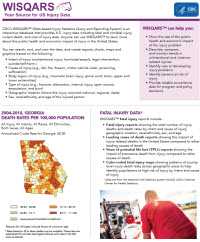WISQARS™ — Your source for U.S. Injury Statistics
CDC’s WISQARS™ (Web-based Injury Statistics Query and Reporting System) is an interactive, online database that provides fatal and nonfatal injury, violent death, and cost of injury data from a variety of trusted sources. Researchers, the media, public health professionals, and the public can use WISQARS™ data to learn more about the public health and economic burden associated with unintentional and violence-related injury in the United States.
Users can search, sort, and view the injury data and create reports, charts, and maps based on the following:
- Intent of injury (unintentional injury, violence-related, homicide/assault, legal intervention, suicide/intentional self-harm)
- Mechanism (cause) of injury (e.g., fall, fire, firearm, motor vehicle crash, poisoning, suffocation)
- Body region (e.g., traumatic brain injury, spinal cord, torso, upper and lower extremities)
- Nature (type) of injury (e.g., fracture, dislocation, internal injury, open wound, amputation, and burn)
- Geographic location (national, regional, state)
- Sex, race/ethnicity, and age of the injured person
Fatal Injury Data*
WISQARS™ fatal injury reports include:
- Fatal injury reports showing the total number of injury deaths and death rates by intent and mechanism (cause) of injury, geographic region/state, race/ethnicity, sex, and age.
- Leading causes of death reports showing the impact of injury-related deaths in the United States compared to other leading causes of death.
- Years of potential life lost (YPLL) reports showing the impact of premature death resulting from injury compared to other leading causes of premature death.
- Color-coded fatal injury maps showing patterns of county-level injury death rates across geographic areas (national, regional, and state level) to help users identify populations at high risk of injury by intent and mechanism (cause) of injury. Learn more about the fatal injury maps.
* Data are from the National Vital Statistics System (NVSS), CDC’s National Center for Health Statistics.
Use WISQARS™ to:
- Show the size of the public health and economic impact of the injury problem
- Describe, compare, and monitor trends in unintentional and violence-related injuries
- Identify new or developing injury problems
- Identify persons at risk of injury
- Provide reliable surveillance data for program and policy decisions
Nonfatal Injury Data**
WISQARS™ nonfatal injury data reports include:
- Nonfatal injury reports providing national estimates of injuries treated in U.S. hospital emergency departments (ED) by intent and mechanism (cause) of injury, race/ethnicity, sex, and disposition when released from the ED (hospitalized, moved for specialized care, treated and released).
- Leading cause of nonfatal injury reports ranking leading causes of nonfatal injuries treated in EDs by age and sex of the injured patient, intent of injury, and disposition when released from the ED.
** Data are from the National Electronic Injury Surveillance System – All Injury Program (NEISS-AIP) operated by the U.S. Consumer Product Safety Commission with CDC’s NCIPC.
Violent Death Data***
WISQARS™ violent death data reports include the following information:
- Number of violent-related deaths and death rates
- Intent of injury (unintentional, homicide, legal intervention, suicide, undetermined intent, and homicide followed by suicide)
- Mechanism (cause) of injury (e.g., firearm, cut/pierce/stab, hanging/suffocation, poisoning)
- Details about victims and offenders, including demographics, victim-offender relationship, veteran status, and facts about the injury incident found at National Violent Death Reporting System (NVDRS)
- Details about suicide victims suspected of a recent homicide
***Data are from the National Violent Death Reporting System (NVDRS) operated by CDC’s NCIPC.
Cost of Injury Data****
WISQARS™ provides cost estimates for injury deaths (including violent deaths) and nonfatal injuries where the patient was treated and released from a hospital or ED.
Cost of injury reports include the following information:
- Medical costs (e.g., treatment and rehabilitation)
- Work loss costs (e.g., lost wages, benefits, and self-reported household services)
- Combined costs (medical plus work loss)
Learn more about the cost of injury reports >>
**** Cost of injury data are based on medical and work loss costs in 2010. Cost estimates for more recent years will be available in the future. Fatal data are from NVSS. Nonfatal data are from NEISS-AIP. Estimated unit lifetime medical and lifetime work loss costs were developed by the Pacific Institute for Research and Evaluation (PIRE).
- Page last reviewed: June 14, 2017
- Page last updated: June 14, 2017
- Content source:
- Centers for Disease Control and Prevention, National Center for Injury Prevention and Control


 ShareCompartir
ShareCompartir
